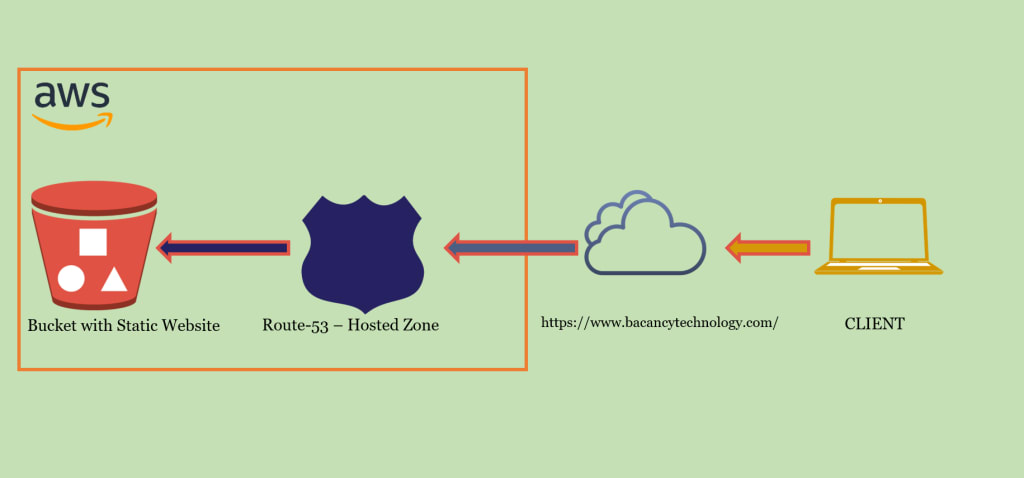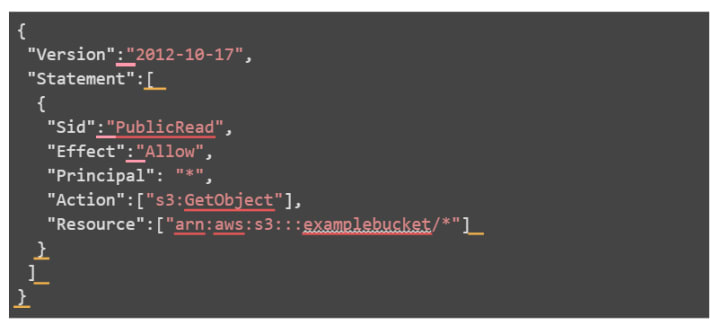Cut Costs and Complexity: How to Host Your Static Site on Amazon S3 in 5 Easy Steps
Hosting a website on Amazon S3 - A Step-by-Step Guide

Introduction
Hosting a website on Amazon S3 offers advantages over traditional web hosting. S3 provides scalability, availability, and durability for web content in the cloud. It is also a cost option, as you only pay for the resources you use.
Amazon S3 empowers everyone to host their website, which compiles HTML, CSS, JavaScript, images, and videos. All you need to do is create an S3 bucket, set it up for website hosting, upload all site data, work on permissions, and link your domain. These steps are pretty simple. You can launch a global static site capable of handling sudden traffic increases.
This guide will help you host a website on Amazon S3. It will cover creating and configuring an S3 bucket, uploading your website files, managing access permissions and policies connecting your custom domain name, and testing your finalized website. It is ideal for those looking to cut costs and simplify their hosting infrastructure. Additionally, we'll touch upon Amazon S3 pricing considerations to ensure transparency in your hosting budget.
Prerequisites
Now, we can start hosting our static website on S3. However, before moving ahead, it is necessary to understand and fulfill a few prerequisites,
- AWS Account: Having an active AWS account is a must. Only then can you create S3 buckets and assess other AWS services required for hosting your website. You can log in to your existing account or sign up for a new account on any AWS site.
- Registered Domain: Is creating a website without a domain possible? So, could you keep the domain name ready and configured for your website? If you do not have a domain, you can register one directly within Amazon Route 53.
- Working Knowledge of Amazon S3: You might come across many technical terms that sometimes may feel alien to you. Therefore, a basic knowledge of what Amazon S3 is, what it does, and how it works will be helpful while hosting a static website. You can explore Amazon's S3 documentation to get a gist of S3.
Once you are sure that you have met all the prerequisites, we can start with creating your S3 bucket to store your website data.
Create an Amazon S3 Bucket
Amazon S3 enables users or customers to upload, store, and download files of any size and type. Nevertheless, to host a website on S3, creating a bucket in S3 where you can store and retrieve your website files is mandatory.
When creating your S3 bucket, follow these best practices:
- Bucket names: Pick a unique name that identifies your website or brand. Bucket names must be globally unique across all S3 users. Include your domain name if available (e.g., example.com). Use hyphens instead of spaces or periods.
- Region selection: To optimize latency, choose the S3 region geographically closest to your website visitors. Popular areas include the US East (N. Virginia) and Europe (Frankfurt). Once created, a bucket's region cannot be changed.
- Permissions: Set the bucket access policy for public reading so your website content is accessible to everyone. You can restrict access to bucket operations like uploads and deletions.
- To create a bucket:
- Log into the AWS Management Console and open the S3 service.
- Click "Create bucket" and enter a unique DNS-compliant name.
- Select the desired AWS region for your bucket.
- Accept the default settings and click "Create bucket" to complete.
Following these steps, create an S3 bucket to receive your website data. Once the S3 bucket is done, you can configure it for website hosting and upload your site's data. Be proactive and careful while managing bucket permissions. The access to ‘can read’ and ‘can write’ must be allocated very diligently.
Configure Bucket for Static Website Hosting
Enabling static website hosting and setting index and error documents allows you to configure the S3 bucket and prepare it to host a static website.
To configure the S3 bucket to host a static website, you must enable static website hosting and set the index and error documents.
To enable static website hosting:
- Go to the Amazon S3 console - Navigate to your S3 bucket.
- Click on the Properties tab.
- Scroll down to the Static Website Hosting section.
- Click on ‘Edit’ to enable the static website hosting.
- Select ‘Enable’ and fill in the appropriate index and error documents.
- The index document, typically named index.html, is the default page to be served when a request comes in for the root domain or any subfolder.
- The error document, like 404.html, is the page that will be shown when a requested resource does not exist in the bucket.
- Ensure to enter index.html for the Index document and an appropriate error page filename like 404.html for the Error document.
6. Click ‘Save Changes’ at the bottom to apply the static website hosting settings.
The bucket is now configured to host the static website and will render the index.html page on requests to the root domain or subfolders and custom error pages when a requested resource is not found.

Upload Website Content to Amazon S3
Upload all the website files and assets to the S3 bucket you created; only then can you host the static website on Amazon S3. Remember to follow best practices for structure and organization while organizing your website content.
Structure Your Website Assets in S3 Folders
A clean, logical folder structure will make it easier to manage your website files over time. Here are some common approaches:
- Create a root folder for your site, such as examplesite.com
- Within that, create folders like /CSS, /js, /images to store these assets
- Your main index.html page can live at the root level
- Use subfolders as needed, like /images/icons or /js/plugins
Keeping related files together makes updating, replacing, and maintaining your site assets easier.
Enable Versioning
- An important feature to enable on your S3 bucket is versioning. This will keep multiple variants of your files whenever you upload changes.
- Enabling versioning gives you access to a provision that allows you to easily roll back to a previous version of the file if needed.
- Go to - Properties tab of your S3 bucket - Enable it.
Avoid Deeply Nested Folders
- Avoid an overly complex nesting of folders and subdirectories in S3. For the best performance, stick to a relatively flat hierarchy.
- Too many levels of folders can impact the S3 bucket's ability to locate files efficiently when rendering pages.
Use Consistent Naming Conventions
When you're naming your files and folders, you should stick to a naming scheme that is clear and consistent. For example:
- Lowercase letters and hyphens (not underscores)
- Descriptive names like contact-page.html
- Version numbers like style-v2.css
This will keep your bucket organized as it continues to grow.
By structuring your S3 bucket properly and uploading assets carefully, you can reliably host your static site for the long haul.
Set Permissions and Policies
To make the static website accessible to everyone, the objects (files and folders) in the S3 bucket must be set to public access. This allows anyone online to view the files without needing permissions or credentials.
By default, all newly created S3 buckets and objects are private. To make them public:
- Select the S3 bucket, go to the Permissions tab, and edit the bucket policy.
- Add a statement to grant public read access, similar to:

- Save the bucket policy. This will now allow public read access to all objects in the bucket.
Consider security implications:
- Sensitive data should not be hosted publicly unless access needs to be unrestricted.
- If only some objects need to be public, selective permissions can be set at the object level instead of the bucket.
- HTTPS should be used to secure the transmission of content over the internet.
- Remember that setting up public access allows anyone online to view the files without credentials. Proceed with caution and consider security implications.
- While planning static site hosting, factoring in Amazon S3 pricing is crucial to ensure cost-effective operations.
Your static website hosted on Amazon S3 is now accessible to the public. The following section explains the domain configuration to connect your custom domain to the S3 bucket.
Domain Configuration
Integrating your domain with the S3 bucket involves configuring DNS settings. You can use Amazon Route 53 or other domain registrars. Follow these steps:
- In the Amazon Route 53 console, choose "Hosted zones" and select your domain.
- Click "Create Record Set" and configure the record set with the details provided by S3 when enabling static website hosting.
- Save the changes
Testing the Static Website
Could you verify the hosted static website by accessing it through the configured domain? If any common issues arise during testing, troubleshoot them.
Additional Considerations
Consider the following aspects to enhance your static website hosted on Amazon S3:
- SSL/TLS for Secure Hosting: Implement SSL/TLS for secure data transmission between users and your website.
- Scalability and Performance: Explore AWS features to scale your website based on demand and optimize performance.
Conclusion
Hosting your static website on Amazon S3 offers a cost-effective and straightforward solution. Following these five steps, you've created a simple, scalable static site running on AWS. Explore further AWS features to enhance your website and stay ahead in the digital landscape. Embrace the simplicity and efficiency of hosting on Amazon S3 and cut costs while ensuring a reliable web presence.
FAQs
Can I use Amazon S3 for my entire website, even if it has changing content?
Amazon S3 stores website building blocks like images, videos, and code (HTML, CSS, JavaScript). These don't change often and are called "static content."
However, S3 can't handle dynamic website features that constantly change (like login forms or shopping carts). However, you can use S3 with other Amazon services (like Lambda or EC2) to create these features.
How can I track changes to my website files on S3?
S3 has a version history feature, like a rewind button! This feature lets you see older versions of your files and even restore them if needed. To use it, enable "versioning" in your S3 bucket settings.
How can I keep my website on S3 secure?
Imagine your S3 bucket as a treasure chest. By setting permissions, you can control who can see what's inside. Please make sure only people who need to see your files (like images) have access.
Also, consider using a "secure padlock" (HTTPS) to encrypt data transfer. Remember, for super important information, it's best to use a service other than S3.
Can I use my website address (domain name) with my S3 website?
Yes! You can connect your domain name to your S3 bucket. This is like putting a fancy label on your treasure chest. Services like Amazon Route 53 can help you link the two. Even instructions are included in this blog to guide you through the setup process.
About the Creator
Mahendra Kadam
Mahendra is a master of language and a leader of innovation.
He is a content Maverick, maestro of words, conductor of comedy, expert of silliness, and the creator of captivating content that keeps his readers waiting for more.
Enjoyed the story? Support the Creator.
Subscribe for free to receive all their stories in your feed. You could also pledge your support or give them a one-off tip, letting them know you appreciate their work.






Comments
There are no comments for this story
Be the first to respond and start the conversation.